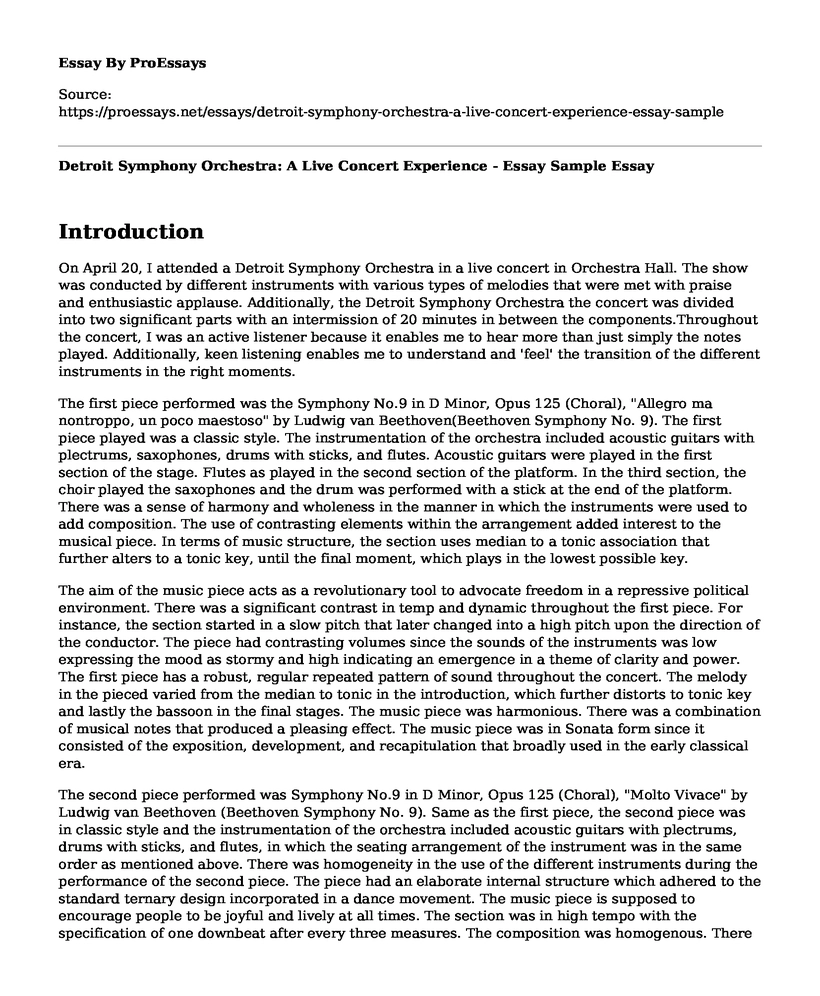Introduction
On April 20, I attended a Detroit Symphony Orchestra in a live concert in Orchestra Hall. The show was conducted by different instruments with various types of melodies that were met with praise and enthusiastic applause. Additionally, the Detroit Symphony Orchestra the concert was divided into two significant parts with an intermission of 20 minutes in between the components.Throughout the concert, I was an active listener because it enables me to hear more than just simply the notes played. Additionally, keen listening enables me to understand and 'feel' the transition of the different instruments in the right moments.
The first piece performed was the Symphony No.9 in D Minor, Opus 125 (Choral), "Allegro ma nontroppo, un poco maestoso" by Ludwig van Beethoven(Beethoven Symphony No. 9). The first piece played was a classic style. The instrumentation of the orchestra included acoustic guitars with plectrums, saxophones, drums with sticks, and flutes. Acoustic guitars were played in the first section of the stage. Flutes as played in the second section of the platform. In the third section, the choir played the saxophones and the drum was performed with a stick at the end of the platform. There was a sense of harmony and wholeness in the manner in which the instruments were used to add composition. The use of contrasting elements within the arrangement added interest to the musical piece. In terms of music structure, the section uses median to a tonic association that further alters to a tonic key, until the final moment, which plays in the lowest possible key.
The aim of the music piece acts as a revolutionary tool to advocate freedom in a repressive political environment. There was a significant contrast in temp and dynamic throughout the first piece. For instance, the section started in a slow pitch that later changed into a high pitch upon the direction of the conductor. The piece had contrasting volumes since the sounds of the instruments was low expressing the mood as stormy and high indicating an emergence in a theme of clarity and power. The first piece has a robust, regular repeated pattern of sound throughout the concert. The melody in the pieced varied from the median to tonic in the introduction, which further distorts to tonic key and lastly the bassoon in the final stages. The music piece was harmonious. There was a combination of musical notes that produced a pleasing effect. The music piece was in Sonata form since it consisted of the exposition, development, and recapitulation that broadly used in the early classical era.
The second piece performed was Symphony No.9 in D Minor, Opus 125 (Choral), "Molto Vivace" by Ludwig van Beethoven (Beethoven Symphony No. 9). Same as the first piece, the second piece was in classic style and the instrumentation of the orchestra included acoustic guitars with plectrums, drums with sticks, and flutes, in which the seating arrangement of the instrument was in the same order as mentioned above. There was homogeneity in the use of the different instruments during the performance of the second piece. The piece had an elaborate internal structure which adhered to the standard ternary design incorporated in a dance movement. The music piece is supposed to encourage people to be joyful and lively at all times. The section was in high tempo with the specification of one downbeat after every three measures. The composition was homogenous. There was a combination of musical notes that produced a fantastic effect. The second piece was in Sonata form because it consisted of the exposition, development, and recapitulation and utilized in the classical period.
The third piece performed was the Symphony No.9 in D Minor, Opus 125 (Choral), "Adagio molto e cantabile" by Ludwig van Beethoven (Beethoven Symphony No. 9). The third piece similar instrumentation of the orchestra and arranged in the same manner as the first and second pieces. There was a sense of harmony and wholeness in the way in which the instruments were used to add composition. The music piece was to entail tranquility of the mind by playing the instrument in a slow movement. The third piece has lyrical slow motion, in a loose variation form and a B-flat major. One could witness that each pair of variations increased progressively, depicting the melody and rhythm of the piece. The last modification was twice disrupted by moments in which loud fanfares for the whole orchestra are answered by melodies played by acoustic guitars alone. There was a combination of musical notes that produced an interesting effect. The third piece was as well loose variation form used in the classical era.
Throughout the experience of hearing the three pieces of Ludwig van Beethoven, I was able to appreciate the talents of the Detroit Symphony Orchestra conducted by Jader Bignamini. This was evidenced by the the ability of the orchestra to understand when to play slow or high tempo depending on the direction of the music conductor.
Work Cited
Beethoven Symphony No. 9. Beethoven Symphony No. 9. 2017, https://www.youtube.com/watch?v=Uj-raECjwGE.
Cite this page
Detroit Symphony Orchestra: A Live Concert Experience - Essay Sample. (2023, May 28). Retrieved from https://proessays.net/essays/detroit-symphony-orchestra-a-live-concert-experience-essay-sample
If you are the original author of this essay and no longer wish to have it published on the ProEssays website, please click below to request its removal:
- The Facebook's Emotional Contagion Study
- The Grapes of Wrath Play Analysis Paper Example
- Essay Example on Modern Art: Overview of Cubism
- Control the Media, Control the Culture: Min Kim's Insightful Analysis Essay
- Essay on Exploring Formal Parallels in Artworks: The Role of Elements and Principles
- Elegy: Exploring Love and Scientific Progress in Nick Payne's Play - Essay Sample
- Postmodernism: A Movement to Challenge Modernism - Free Essay Sample







